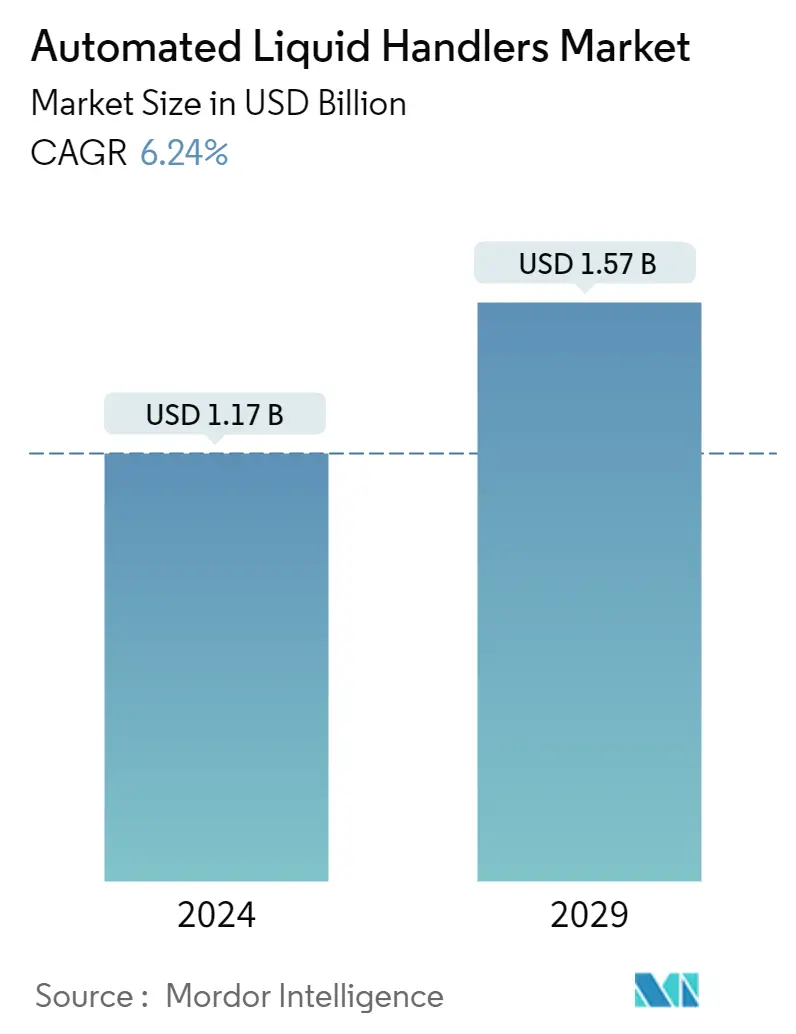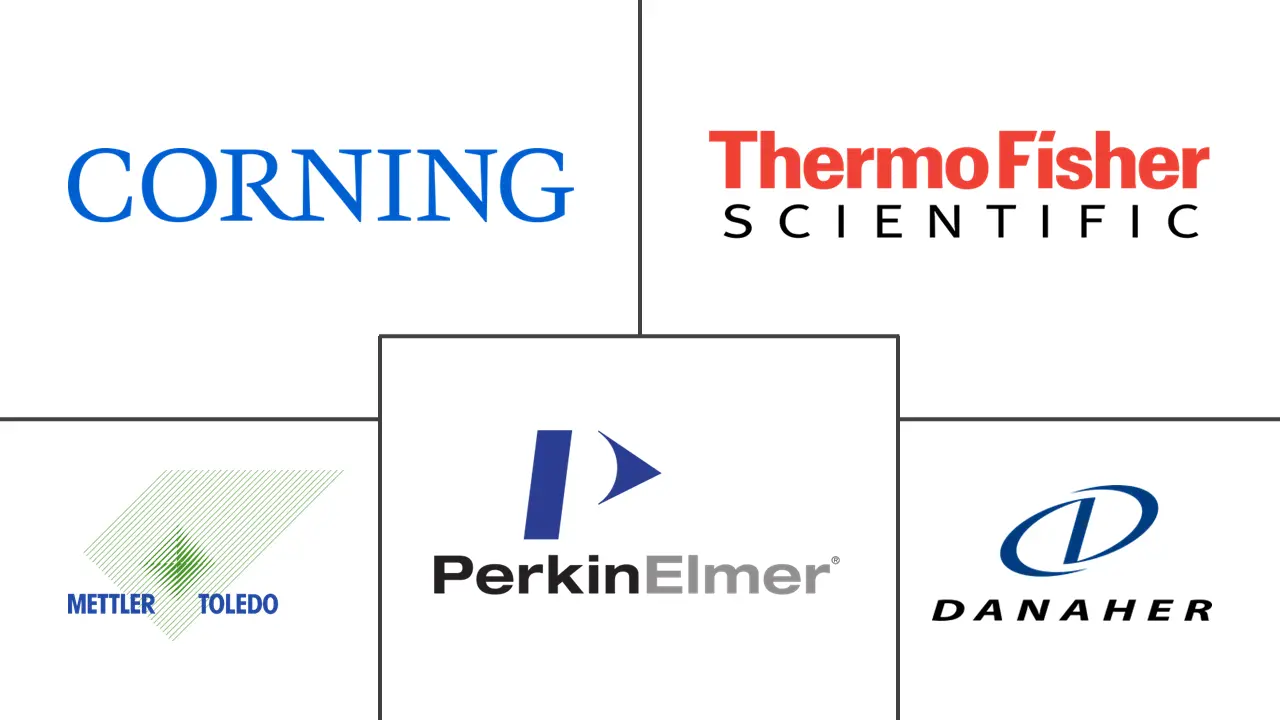Market Size of Automated Liquid Handlers Industry

| Study Period | 2019 - 2029 |
| Market Size (2024) | USD 1.17 Billion |
| Market Size (2029) | USD 1.57 Billion |
| CAGR (2024 - 2029) | 6.24 % |
| Fastest Growing Market | Asia Pacific |
| Largest Market | North America |
Major Players
*Disclaimer: Major Players sorted in no particular order |
Automated Liquid Handlers Market Analysis
The Automated Liquid Handlers Market size is estimated at USD 1.17 billion in 2024, and is expected to reach USD 1.57 billion by 2029, growing at a CAGR of 6.24% during the forecast period (2024-2029).
With the outbreak of COVID-19, the automated liquid handler market witnessed a significant increase in demand due to the increasing requirement for testing, tracing, and tracking in diagnostic labs globally. As the volume of incoming samples, especially related to the pandemic situation, laboratories need many capabilities to test up to thousands of samples daily.
- Automation systems' flexibility and adaptability made automated liquid handlers' equipment widely used in lab automation. They reduce processing time and the possibility of sample contamination by dispensing dead volumes efficiently. Liquid handlers can work with volumes as small as nanoliters, making them helpful in dispensing operations.
- There is a wide range of automated liquid handling systems on the market. They are air-based or liquid-filled systems for pipetting with either/or a combination of fixed and disposable tips. Automation platforms with liquid detection systems record aspiration action and assist when bioanalytical sample volumes are low.
- Furthermore, the rapid expansion of several clinical and pre-clinical studies worldwide, particularly in the United States, has created a need for speed in sample analysis. The machines in clinical studies run continuously and require a large workforce to ensure proper operation. Furthermore, the rapid spread of existing diseases and the discovery of new diseases raises the demand for early treatments and diagnoses. This is expected to boost the rate of clinical diagnostic application, fueling the adoption of automated liquid handlers.
- Furthermore, in January 2021, SPT Labtech acquired Apricot Designs. Through this purchase, SPT aimed to extend its range of liquid handling technologies as part of its collection of automation resolutions for structural biology, drug discovery, sample managing, genomics, biobanking, and cryo-electron microscopy. Such developments are anticipated to further drive the market growth.
- The increasing need for faster turn-around times (TAT), higher throughput, reduced human errors, and lower operational costs are some of the major factors driving the adoption of automated liquid handlers. Liquid handlers are typically employed in biochemical and chemical laboratories. Automatic liquid handling robots aid in the dispensing of samples and other liquids in laboratories. Liquid handlers use a software controller and an integrated system to customize handling procedures for large transfer volumes.
- Further, in June 2021, the German laboratory Merck announced its plan to invest EUR 175 million in France. About EUR 50 million was invested in the Gironde laboratory, which planned to triple its production, specializing in drugs derived from biotechnologies to treat cancer.
- Furthermore, advanced liquid handling technologies, such as automatic positive displacement pipetting systems, allow users to handle highly viscous to highly volatile liquids in lower volume ranges and with a broader range of liquid types. Beckman Coulter has introduced a new line of scalable liquid handling solutions for genomic, cellular, protein, and other workflows. The newly released Biomek 4000 Automated Liquid Handler aids in standardizing daily pipetting routines, preserving sample quality, and generating repeatable and reliable results.
Automated Liquid Handlers Industry Segmentation
The market studied has been segmented based on Applications such as Drug Discovery, Cancer and Genomic Research, and Biotechnology, among various others, End-User verticals such as Contract Research Organizations, pharmaceuticals, and Biotechnology, and Academic and Research Institutes in different geographies. The study also covers the impact of COVID-19 on the market.
| By Application | |
| Drug Discovery | |
| Cancer and Genomic Research | |
| Biotechnology | |
| Other Applications |
| By End-user Vertical | |
| Contract Research Organizations | |
| Pharmaceutical and Biotechnology | |
| Academic and Research Institutes |
| By Geography | |
| North America | |
| Europe | |
| Asia Pacific | |
| Latin America | |
| Middle East and Africa |
Automated Liquid Handlers Market Size Summary
The automated liquid handling market is experiencing significant growth, driven by the increasing demand for efficient and accurate sample processing in laboratories. The market's expansion is largely attributed to the heightened need for testing and diagnostics, particularly in the wake of the COVID-19 pandemic, which underscored the importance of rapid and reliable sample analysis. Automated liquid handlers are becoming integral in laboratory settings due to their ability to handle small volumes with precision, reduce processing times, and minimize the risk of contamination. These systems are versatile, accommodating various liquid types and volumes, and are essential in clinical and pre-clinical studies where speed and accuracy are paramount. The market is characterized by a diverse range of products, including air-based and liquid-filled systems, which are increasingly adopted to enhance laboratory automation and improve operational efficiency.
The market is moderately fragmented, with key players like Thermo Fisher Scientific, Perkin Elmer Inc., and Beckman Coulter Inc. leading the charge through innovation and strategic partnerships. Recent acquisitions and product launches, such as SPT Labtech's acquisition of Apricot Designs and the introduction of new automated liquid handling platforms, highlight the ongoing advancements in this sector. The demand for automated liquid handlers is further bolstered by the growing need for faster turnaround times, higher throughput, and reduced human error in laboratory processes. Additionally, the expansion of clinical diagnostics and the increasing focus on drug discovery and research are driving the adoption of these technologies. As laboratories continue to evolve, the integration of advanced automation solutions is expected to play a crucial role in meeting the rising demands of the healthcare and research industries.
Automated Liquid Handlers Market Size - Table of Contents
-
1. MARKET INSIGHTS
-
1.1 Market Overview
-
1.2 Industry Value Chain Analysis
-
1.3 Industry Attractiveness - Porter's Five Forces Analysis
-
1.3.1 Bargaining Power of Suppliers
-
1.3.2 Bargaining Power of Buyers
-
1.3.3 Threat of New Entrants
-
1.3.4 Intensity of Competitive Rivalry
-
1.3.5 Threat of Substitutes
-
-
1.4 Assessment of the Impact of COVID-19 on the Market
-
-
2. MARKET SEGMENTATION
-
2.1 By Application
-
2.1.1 Drug Discovery
-
2.1.2 Cancer and Genomic Research
-
2.1.3 Biotechnology
-
2.1.4 Other Applications
-
-
2.2 By End-user Vertical
-
2.2.1 Contract Research Organizations
-
2.2.2 Pharmaceutical and Biotechnology
-
2.2.3 Academic and Research Institutes
-
-
2.3 By Geography
-
2.3.1 North America
-
2.3.2 Europe
-
2.3.3 Asia Pacific
-
2.3.4 Latin America
-
2.3.5 Middle East and Africa
-
-
Automated Liquid Handlers Market Size FAQs
How big is the Automated Liquid Handlers Market?
The Automated Liquid Handlers Market size is expected to reach USD 1.17 billion in 2024 and grow at a CAGR of 6.24% to reach USD 1.57 billion by 2029.
What is the current Automated Liquid Handlers Market size?
In 2024, the Automated Liquid Handlers Market size is expected to reach USD 1.17 billion.

